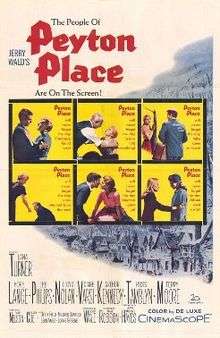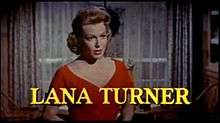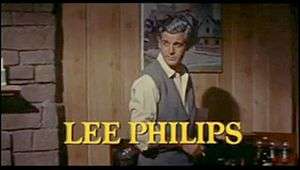Peyton Place (film)
| Peyton Place | |
|---|---|
 | |
| Directed by | Mark Robson |
| Produced by | Jerry Wald |
| Screenplay by | John Michael Hayes |
| Based on |
Peyton Place by Grace Metalious |
| Starring | |
| Music by | Franz Waxman |
| Cinematography | William C. Mellor |
| Edited by | David Bretherton |
Production company |
Jerry Wald Productions |
| Distributed by | 20th Century Fox |
Release date |
|
Running time | 162 minutes |
| Country | United States |
| Language | English |
| Budget | $2.2 million[3] or $1.8 million[4] |
| Box office | $25.6 million |
Peyton Place is a 1957 American film drama from 20th Century Fox, shot in color by De Luxe and in CinemaScope. It was produced by Jerry Wald, directed by Mark Robson, and stars Lana Turner and Hope Lange. In co-starring and supporting roles are Lee Philips, Lloyd Nolan, Diane Varsi, Arthur Kennedy, Russ Tamblyn, and Terry Moore. The film is based on the bestselling 1956 novel of the same name by Grace Metalious.
The film's storyline follows the residents of a small fictional New England mill town in the years surrounding World War II, where scandal, homicide, suicide, incest, and moral hypocrisy belie its tranquil façade.
Plot
In April 1941, in the New England town of Peyton Place, drunkard Lucas Cross (Arthur Kennedy) stumbles out of his house, just as his step-son Paul, fed up with Lucas's alcoholism, leaves town. Lucas's downtrodden wife, Nellie (Betty Field), becomes the housekeeper for Constance "Connie" MacKenzie (Lana Turner), a prim local dress shop owner. The daughters of both families, Allison MacKenzie (Diane Varsi) and Selena Cross (Hope Lange), are best friends and are about to graduate high school.
A stranger, Michael Rossi (Lee Philips), is hired to be the new high school principal by school board president Leslie Harrington (Leon Ames); the students' choice for the position is long-time teacher Ms. Elsie Thornton (Mildred Dunnock). Rossi wins over Ms. Thornton by saying that he wants to work with her.
Later, Connie encourages her daughter to uninvite Betty Anderson (Terry Moore) to the party, due to Betty's overt sexuality; Constance finally reconsiders, allowing Allison to invite anyone she wishes. At the party, Betty arrives with Leslie Harrington's son Rodney (Barry Coe), who turns it into a make-out party, kissing Allison; the party ends when Connie makes a scene, embarrassing Allison. Before church the next day, Allison witnesses Lucas beating his step-daughter, Selena.
Later, at the MacKenzie house, Rossi announces that Allison has been named valedictorian, and he asks Connie to chaperone Allison's graduation dance; the two slowly develop a romance. Meanwhile, Harrington informs his son Rodney that he does not approve of his going with Betty Anderson, because of her bad reputation, so Rodney is forced to uninvite her.
Rodney goes with Allison instead, though Allison is in love with shy Norman Page (Russ Tamblyn), whose mother, Evelyn Page (Erin O'Brien-Moore) is overprotective. At the dance, Rodney splits off to make-out with Betty, but she is angry at him for dumping her and so refuses to have sex.
During the traditional singing of "Auld Lang Syne", Mr. Rossi realizes that he is still not a part of the town's traditions, and thus asks Ms. Thornton to give a little speech and lead the song. This annoys Marion Partridge (Peg Hillias), a member of the school board who is a malicious gossip (she didn't liked Ms. Thornton at all); she is also the wife of the town's leading attorney, Charles Partridge (Staats Cotsworth), who was also on the school board, along with the compassionate Seth Bushwell (Robert H. Harris), the editor of the town's newspaper, The Peyton Place Times.
After the dance, Selena is raped by her step-father, Lucas. She becomes pregnant, and when she goes to see Dr. Matthew Swain (Lloyd Nolan), the town's leading physician (and another member of the school board), for an abortion he refuses; she confides in him that her step-father raped her.
A furious Dr. Swain confronts Lucas, and he is forced to promise to leave town after signing a confession, all of which Nellie secretly witnesses. Now out for revenge, Lucas chases Selena when she returns home, and although she escapes, she falls, injuring herself. After treating her, Swain records that she had an "appendectomy", when in fact she has had a miscarriage.
At a Labor Day parade/picnic later that year, Rodney and Betty reunite and go skinny dipping, while nearby, Allison and Norman go swimming in proper suits. Marion sees a naked couple and falsely makes an assumption, telling Connie it was Allison and Norman. Connie and Allison have a fight; in a fit of anger, Connie admits that Allison's father was married to another woman when she became pregnant.
Upset, Allison runs upstairs and discovers that Nellie Cross has committed suicide. Allison goes into a state of shock, and is confined to bed. Sometime after, Rodney and Betty elope, infuriating Rodney's father Leslie. After recovering, Allison leaves for New York City.
World War II erupts in 1941, and Peyton Place's men go off to war. When Rodney is killed in action, his father offers to take care of his widow, Betty, and she is finally welcomed into the family. During Christmas of 1942, Connie visits Rossi to apologize for being dismissive of him.
When confessing that she was a married man's mistress, Rossi decides to stay in Peyton Place, saying that his marriage proposal to her is still open. A drunken Lucas returns from the Navy and tries to rape Selena again, but this time she bludgeons him to death in self-defense.
After Easter of 1943, Selena tearfully confesses to Connie, and she is later arrested and tried by the District Attorney (Lorne Greene) for Lucas' murder. Allison, still estranged from Connie, returns for the trial, as does Norman; the truth about Selena's self-defense, her step-father's abuse, her miscarriage, as well as Dr. Swain's false report, all come to light.
Dr. Swain admonishes the town for their gossipy ways and failure to offer Selena help when she needed it most. Ultimately, Selena is acquitted, and she and Ted are free to marry.
Allison has a change of heart and approaches Connie with a hope of reconciliation, and Norman is welcomed into the house.
Cast
- Lana Turner as Constance MacKenzie
- Diane Varsi as Allison MacKenzie
- Hope Lange as Selena Cross
- Lee Philips as Michael Rossi
- Arthur Kennedy as Lucas Cross
- Lloyd Nolan as Dr. Matthew Swain
- Russ Tamblyn as Norman Page
- Terry Moore as Betty Anderson
- David Nelson as Ted Carter
- Barry Coe as Rodney Harrington
- Betty Field as Nellie Cross
- Mildred Dunnock as Miss Elsie Thornton
- Leon Ames as Leslie Harrington
- Lorne Greene as District Attorney
- Staats Cotsworth as Charles Partridge
- Peg Hillias as Marion Partridge
- Tami Conner as Margie (a classmate of Selena and Allison)
- Erin O'Brien Moore as Mrs. Evelyn Page
- Scotty Morrow as Joey Cross (uncredited)
Cast notes
- Both Diane Varsi and Lee Philips made their film debuts in Peyton Place.[5]
- The films also marked the first time that David Nelson had appeared separately from his family, Ozzie, Harriet and Ricky.[5]
- Erin O'Brien-Moore, who played Mrs. Evelyn Page, would play Nurse Esther Choate in the TV series, Peyton Place in the sixties.
Production
Less than a month after the novel's release in 1956, producer Jerry Wald bought the rights from author Grace Metalious for $250,000 and hired her as a story consultant on the film, although he had no intention of actually allowing her to contribute anything to the production. Her presence in Hollywood ensured the project additional publicity, but Metalious soon felt out of place in the film capital. Horrified by the sanitized adaptation of her book by screenwriter John Michael Hayes, who was forced to contend with the Hays Code, and his suggestion Pat Boone be cast as Norman Page, she returned to her home in Gilmanton, New Hampshire. She hated the film, but she eventually earned a total of $400,000 in exhibition profits from it.[6]
The novel never mentioned the state explicitly, but it made several references strongly suggesting that Peyton Place was located within the state of New Hampshire, whereas the film makes no clear references to any particular New England state. The film was shot primarily in Maine, mostly in the town of Camden, with additional exteriors filmed in Belfast, Rockland and Thomaston,[5] as well as Lake Placid in New York.
Release
The film premiered in Camden one day before opening in 24 cities across the US on December 12, 1957.[1][2]
Peyton Place was the second-highest-grossing film of 1958, although in the first few months of its release it did not do well at the box office, until a real-life tragedy gave it an unexpected boost. On April 4, 1958, star Lana Turner's daughter Cheryl killed her mother's abusive lover, mobster Johnny Stompanato, and was placed in Juvenile Hall. The press coverage of the subsequent investigation boosted ticket sales by 32%, and the film eventually grossed $25,600,000 in the U.S. A coroner's inquest ruled the murder justifiable homicide, and the district attorney chose not to charge Cheryl with the crime, although he declared her a ward of the state and placed her in the custody of her grandmother. Turner feared the negative publicity would end her career, but it led producer Ross Hunter to cast her in the 1959 film Imitation of Life.[6] According to Wald, Peyton Place earned $10.1 million in 4,185 theatres.[4]
Peyton Place was also a popular prime time television series that aired from September 1964 until June 1969.
The film is recognized by the American Film Institute:
- 2005: AFI's 100 Years of Film Scores – Nominated[7]
Critical reception
While Peyton Place was a commercial hit, most critics noted that the most salacious elements of the Metalious novel had been whitewashed or eliminated completely. In The New York Times, Bosley Crowther remarked, "There is no sense of massive corruption here."[8] However, he did generally like the film, praising Hope Lang for a "gentle and sensitive performance" and finding Lloyd Nolan "excellent."[9] Variety wrote that the film was "impressively acted by an excellent cast," but noted that "in leaning backwards not to offend, Wald and Hayes have gone acrobatic ... On the screen is not the unpleasant sex-secret little town against which Grace Metalious set her story. These aren't the gossiping, spiteful, immoral people she portrayed. There are hints of this in the film, but only hints." [10] Richard L. Coe of The Washington Post wrote, "While the four-letter words of the Grace Metalious novel have been adroitly erased, it's easy for one of the apparent few who didn't read the book to see why so many did. There are several strong stories and the characters are sharply drawn. Without these two characteristics the best written novels remain unread."[11] Edwin Schallert of the Los Angeles Times declared the film "probably the most powerful small-town picture ever produced,"[12] and Harrison's Reports praised it as "an absorbing adult drama" that "grips one's attention the whole time it is on the screen, thanks to the sensitive direction and the effective acting of the capable cast."[13] John McCarten of The New Yorker was negative, writing that the film "makes no attempt to exploit the sensational aspects of the tale it has to tell; on the contrary, it is woefully diffuse, and before it's over—roughly, three hours—boredom has set in like the grippe."[14] The Monthly Film Bulletin wrote, "Slick and passionless, the film is an expensive and heavily bowdlerised adaptation of Grace Metalious' best-seller," adding that "the film never quite makes up its mind whether to extol small-town America or castigate it."[15]
TV Guide said, "This is the kind of hypertensive trash that gives melodrama a bad name, cynically tempering its naughty bits with smug moralizing. The fact that the film won an 'A' rating from the Catholic Legion of Decency, meaning it was deemed 'acceptable to all,' is a dead giveaway.[16] (In actuality, it was given an "A-III" rating, meaning appropriate only for adults.)[17]
On the film's 40th anniversary in 1998, celebrations were held in some of the Maine towns in which the film was shot, attended by Hope Lange.
Accolades
The film received nine Oscar nominations (and no wins), including four honoring supporting performances, which tied a record set three years earlier by On the Waterfront. That record would later be matched by Tom Jones, and The Godfather Part II. The film's nine Oscar nominations without a win also tied a then-Academy Award's record for biggest shut-out (with The Little Foxes). That record was later surpassed by The Turning Point in 1977 and The Color Purple in 1985, both of which won zero of eleven nominations.
- Best Motion Picture: Jerry Wald, Producer
- Best Director: Mark Robson
- Best Actress: Lana Turner
- Best Supporting Actress: Diane Varsi
- Best Supporting Actress: Hope Lange
- Best Supporting Actor: Arthur Kennedy
- Best Supporting Actor: Russ Tamblyn
- Best Writing (Screenplay--based on material from another medium): John Michael Hayes
- Best Cinematography: William Mellor
Gallery
See also
References
- 1 2 "Today in History - Monday, December 11". Telegram & Gazette. December 11, 2017. Retrieved July 8, 2018.
- 1 2 "'Peyton Place' Showings On Limited Runs Basis". Motion Picture Daily: 3. December 9, 1957. Retrieved July 8, 2018.
- ↑ Solomon, Aubrey. Twentieth Century Fox: A Corporate and Financial History (The Scarecrow Filmmakers Series). Lanham, Maryland: Scarecrow Press, 1989. ISBN 978-0-8108-4244-1. p251
- 1 2 HOLLYWOOD SCENE: Jerry Wald Presents His Treasurer's Report -- Blaustein's 'Horsemen' By THOMAS M PRYOR HOLLYWOOD.. New York Times (1923-Current file) [New York, N.Y] 27 July 1958: X5.
- 1 2 3 "Notes" on TCM.com
- 1 2 Kashner and McNair, pp.248-51
- ↑ "AFI's 100 Years of Film Scores Nominees" (PDF). Retrieved 2016-08-06.
- ↑ Kashner and McNair, p. 253.
- ↑ Crowther, Bosley (December 13, 1957). "The Screen: Drama in 'Peyton Place'". The New York Times: 35.
- ↑ "Film Reviews: Peyton Place". Variety: 6. December 18, 1957.
- ↑ Coe, Richard L. (December 20, 1957). "Vivid Account Of Best Seller". The Washington Post: B6.
- ↑ Schallert, Edwin (December 13, 1957). "'Peyton Place' Thoroughly Dissects Small-Town Life". Los Angeles Times: Part III, p. 16.
- ↑ "Film Review: Peyton Place". Harrison's Reports: 198. December 14, 1957.
- ↑ McCarten, John (December 21, 1957). "The Current Cinema". The New Yorker: 54.
- ↑ "Peyton Place". The Monthly Film Bulletin. 25 (292): 58–59. May 1958.
- ↑ TV Guide review
- ↑ "Archived copy". United States Conference of Catholic Bishops. Archived from the original on 2013-04-16. Retrieved 2012-04-30.
Works cited
- Cameron, Ardis. Unbuttoning America: A Biography of 'Peyton Place'.. Ithaca, New York: Cornell University Press, 2015. ISBN 978-0-80145609-1. (available online)
- Kashner, Sam and Jennifer MacNair. The Bad and the Beautiful: Hollywood in the Fifties. New York: W.W. Norton & Company, Inc., 2002., ISBN 0-393-04321-5
External links
| Wikimedia Commons has media related to Peyton Place (film). |



